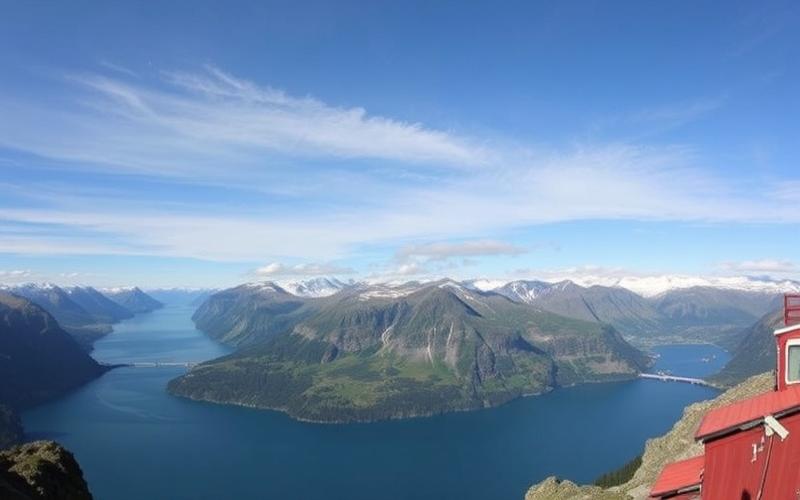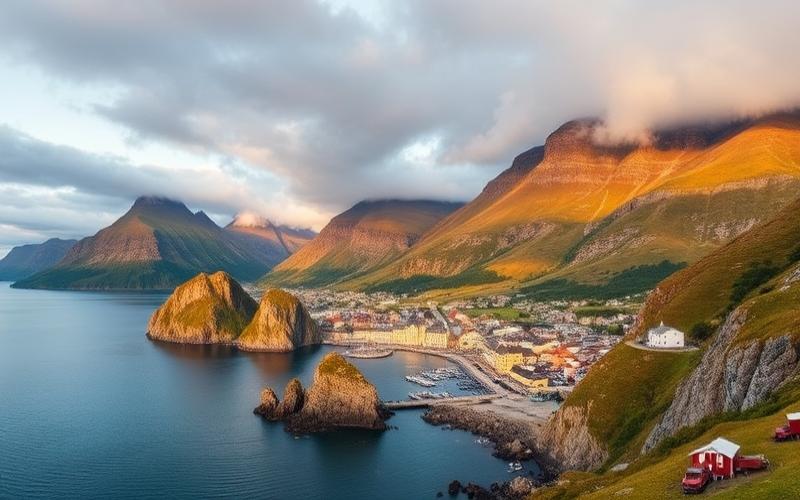
 Published on and written by Cyril Jarnias
Published on and written by Cyril Jarnias
Norway, a country of captivating landscapes and vibrant cities, boasts an exceptionally efficient and well-organized public transportation network, making it easy to discover its natural and cultural wonders.
Whether in the bustling streets of Oslo, the picturesque charm of Bergen, or the spectacular routes crossing the fjords, transport options like trains, buses, and ferries will allow you to explore the country with ease and comfort.
Thanks to modern and eco-friendly infrastructure, every journey becomes an experience in itself, offering an authentic glimpse into the Norwegian way of life.
This practical guide provides you with essential information to navigate this intuitive transportation system and fully enjoy your stay in this enchanting Nordic country.
Exploring Transportation Modes in Norway
Public Transportation Modes in Norway
Norway has a dense, modern, and sustainable public transportation network connecting cities, regions, and rural areas through several complementary modes: trains, buses, ferries, and domestic flights.
| Transport Mode | Main Companies/Operators | Main Connections | Frequency & Schedules | Special Features |
|---|---|---|---|---|
| Trains | Vy (Vygruppen AS), Go-Ahead Nordic, SJ Norge | Oslo-Bergen, Oslo-Trondheim, Oslo-Stavanger, Oslo-Bodø | Frequent departures on major routes, less frequent in the north | Comfort, punctuality, spectacular scenery |
| Buses | Nor-Way Bussekspress, Vy Buss, Unibuss, Nettbuss, Nobina, Kolumbus (Stavanger), Keolis Norge (Bergen), Ruter AS (Oslo/Akershus) | Complementary to trains, intercity and rural connections, service to fjords and non-railway areas | Very regular on weekdays, more limited on weekends, varying schedules by region | Electric and autonomous buses in some cities, connections with trains and ferries |
| Ferries | Hurtigruten, Fjord1, Norled | Coastal routes (Bergen-Kirkenes, fjords, archipelagos), fjord and lake crossings | Daily departures for main lines, schedules adapted for connections | Hybrid or electric ships on some routes, exceptional views |
| Domestic Flights | SAS, Norwegian, Widerøe | Oslo to Tromsø, Bodø, Trondheim, Bergen, Stavanger, connections between northern cities and islands | High frequency on Oslo-main city routes, multiple flights daily | Essential for long distances and remote regions |
Connections and Ease of Use
- Major hubs (Oslo, Bergen, Trondheim, Stavanger) offer seamless connections between trains, buses, ferries, and planes.
- Railway stations are often located immediately near bus terminals and some ferry ports.
- The national journey planner Entur (app and website) allows planning multimodal routes and purchasing most tickets in one operation.
Sustainable Development Initiatives
- Oslo aims for “zero emissions” for public transport by 2030: trams and ferries powered by hydroelectricity, electric bus fleet (e.g., Unibuss in Oslo with 76 MAN Lion’s City E electric buses), tests of autonomous electric buses in Stavanger, electric and automated buses in Bergen (Keolis Norge).
- Massive investments in electric vehicles: Norway has the world’s highest electric vehicle penetration rate, with dense charging networks for cars, buses, and ferries.
- Hybrid and electric ferries: Fjord1 and Norled operate zero-emission ship crossings, particularly in UNESCO World Heritage fjords.
Practical Tips for Travelers
Ticket Purchase
- Train and bus tickets: online via company websites/apps (Vy, Nor-Way, Entur), ticket machines at stations, onboard for some rural buses.
- Ferries: online booking recommended (especially for Hurtigruten), possible on-site depending on availability.
- Flights: online booking (SAS, Norwegian, Widerøe), through agencies or comparison sites.
Available Discounts
- Youth, senior, student, family fares, regional discount cards.
- National or regional passes (e.g., Interrail, Norway in a Nutshell, Travel Pass Nordland).
Useful Apps and Tools
- Entur: multimodal planning and ticket purchases throughout Norway.
- Ruter: for the Oslo and Akershus region, schedules and digital tickets.
- Vy: for national trains and buses, schedules and reservations.
- Nor-Way Bussekspress: schedules and long-distance bus ticket purchases.
Key Tips for Easy Travel
- Prioritize advance booking during high season (summer, holidays, school breaks).
- Check frequency of rural lines, sometimes limited on weekends.
- Enjoy panoramic views: choose daytime trips to admire the landscapes.
- Check schedules on Entur to optimize connections.
- Allow extra time for connections in rural areas or during bad weather.
- Use electronic tickets for more flexibility and to avoid lines.
Norway is a global model for sustainable public transport, combining innovation, efficiency, and environmental respect, while offering travelers a smooth and practical experience.
Good to Know:
Norwegian trains, primarily operated by Vy and Flytoget, offer fast connections between cities with discount possibilities through the NSB discount card. Remember to download the “Entur” app to easily plan your trips combining bus, train, and ferry.
What Budget for Expats?
The cost of public transportation in Norway is relatively high, but there are subscriptions suited to different profiles (adults, students, seniors) as well as discounts for children and families. Here’s an overview of average fares in major cities:
| City | Monthly Subscription (Adult) | Monthly Subscription (Student) | Monthly Subscription (Senior) | Annual Subscription (Adult) |
|---|---|---|---|---|
| Oslo | ≈ €85-100 | ≈ €55-65 | ≈ €55-65 | ≈ €950-1,100 |
| Bergen | ≈ €80-95 | ≈ €50-60 | ≈ €50-60 | ≈ €900-1,000 |
| Trondheim | ≈ €85-95 | ≈ €55-60 | ≈ €55-60 | ≈ €950-1,050 |
Discounts and Special Offers:
- Children: generally, children under 6 travel free with a paying adult. Children aged 6 to 17 receive discounted fares (about 50% of adult fare).
- Families: some networks offer family packages or discounts on weekends and during school holidays.
- Newcomers: temporary promotional offers or discovery packs are sometimes available from local transport companies for expats or international students.
- Students & Seniors: proof required to benefit from reduced fares.
Transport Cost Comparison with Cost of Living
| Expense Item | Monthly Range (Oslo, single adult) |
|---|---|
| Housing (studio/1 bedroom) | €1,000 to €1,600 |
| Food | €350 to €500 |
| Public Transportation | €85 to €100 |
| Other (telecom, leisure) | €100 to €200 |
- Transportation therefore represents 5 to 8% of the monthly budget for a single person, but this percentage can decrease with discounted fares or if multiple family members benefit from discounts.
- Single tickets cost on average €3.50 to €4 depending on the city, but the monthly subscription quickly pays for itself with just 2 daily round trips.
Useful Resources for Expats
- Official local transport network websites: Ruter (Oslo), Skyss (Bergen), AtB (Trondheim).
- Expat portals and specialized forums: Expat.com, Internations, expat Facebook pages in Norway.
- Online practical guides: “Living in Norway” pages on embassy websites, advice sites like “PartirOu”, “Routard”, or “Lonely Planet”.
- Mobile apps: RuterBillett, Skyss Billett, AtB Mobillett to compare and purchase subscriptions or tickets, and track current offers.
Important Tip:
Expats can optimize their transport budget by learning about combinable discounts, purchasing subscriptions via mobile apps, and monitoring seasonal offers (back-to-school, Christmas, summer).
Good to Know:
In Oslo, a monthly public transportation subscription costs about €80 for adults, with discounts for students and seniors, while promotional offers are often available for newcomers; to optimize expenses, consult expat forums and sites like “nav.no”.
Tips for Efficient Travel
Effectively planning a public transportation trip in Norway relies on a few simple tips to implement from the preparation of your stay.
Planning and Purchase Apps
- Using local apps like Ruter (for Oslo and its region) or Vy (for the entire country) allows you to:
- Check real-time schedules for buses, trains, subways, trams, and ferries.
- View optimized routes, including connection times and walking distances.
- Purchase and store your tickets directly on your smartphone.
- Receive notifications in case of delays or service changes.
Advance Ticket Purchase
- Purchasing your tickets online via apps or at ticket machines (available in stations and stops) allows you to:
- Avoid lines, especially during peak hours.
- Sometimes benefit from more advantageous fares compared to onboard purchase.
- Avoid potential penalties or extra costs related to late purchase.
Contactless Payment
Contactless bank cards are very often accepted in Norwegian transportation, facilitating quick boarding, especially on urban buses and trams.
Some apps also allow registering a card for instant payments.
Schedules and Comfort
Traveling outside peak hours (morning: 7-9 AM, evening: 4-6 PM) generally offers more seating and a more relaxed atmosphere.
Fares remain the same, but the travel experience is significantly improved.
Discounts and Preferential Fares
- Discounts exist for:
- Children
- Students (upon presentation of valid ID)
- Seniors
It is recommended to verify and select the correct profile when purchasing tickets on apps or at machines.
Courtesy Rules to Follow
- Yield seats to elderly people, people with reduced mobility, or pregnant women.
- Keep your voice low and avoid blocking access doors.
- Wait for passengers to exit before boarding.
- Do not unnecessarily occupy reserved seats.
| Tip | Recommended App/Action | Main Benefit |
|---|---|---|
| Route Planning | Ruter, Vy, Entur | Accurate schedules, optimized routes |
| Advance Ticket Purchase | Apps, machines, partner stores | Time savings, cost savings |
| Contactless Payment | Bank card or smartphone | Quick boarding |
| Off-Peak Travel | Adjust your schedule | More comfort |
| Discount Verification | Select profile during purchase | Advantageous fares |
| Respect Local Rules | Observe local behaviors | Pleasant travel for all |
Taking the time to plan your trips and respecting local customs guarantees a serene and smooth stay in Norwegian transportation.
Good to Know:
Use local apps Ruter or Vy to plan your routes and check public transportation schedules and fares; remember to purchase your tickets in advance to avoid lines and take advantage of discounts for children, students, or seniors. Prefer traveling outside peak hours for more comfort, and have a contactless payment card for quick boarding while respecting local courtesy rules like yielding seats to the elderly.
Disclaimer: The information provided on this website is for informational purposes only and does not constitute financial, legal, or professional advice. We encourage you to consult qualified experts before making any investment, real estate, or expatriation decisions. Although we strive to maintain up-to-date and accurate information, we do not guarantee the completeness, accuracy, or timeliness of the proposed content. As investment and expatriation involve risks, we disclaim any liability for potential losses or damages arising from the use of this site. Your use of this site confirms your acceptance of these terms and your understanding of the associated risks.




















